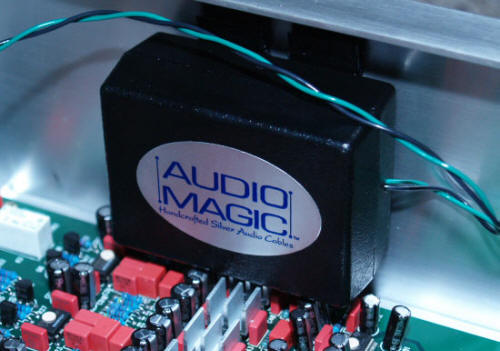
You are reading the older HTML site
Positive Feedback ISSUE
43may/june 2009
audio magic
Pulse Generator ZX for speaker cables
as reviewed by John Hoffman

Shown is the Pulse Gen ZX for 'inside' components
|
JOHN HOFFMAN'S SYSTEM
LOUDSPEAKERS
ELECTRONICS
SOURCES
CABLES
ACCESSORIES
|
The contributions of power conditioners to the performance of a stereo system have been widely accepted by audio enthusiasts. The detrimental effects of power supply line gremlins are well documented, and a myriad of products have been developed to address these issues. AC regeneration and isolation transformers are commonly used in designs that are intended to purify the electricity being fed to an audio system. While these types of units fulfill their function, they do nothing to combat the effects of RFI and EMI on the components further down the signal chain. After all, many audio systems will have interconnects and speaker wire that do not use shielding, and the wire and circuit traces in components are avenues for noise to enter a system. Even the components themselves can generate RFI or EMI signals. Since many hobbyists have taken to using hard drive based music servers, a laptop computer placed in close proximity to the stereo system can bleed copious amounts of electronic hash into the music. Until now, only passive filter systems have been used in an attempt to address this issue.
Jerry Ramsey at Audio Magic has been able to adapt the Pulse Generator technology embedded in the Stealth line of power conditioners to a wide range of applications. The first product to be spun off was the Pulse Generator ZX module, which needs to be placed within a component. These modules radiate a field that cancels RFI and EMI signals, and only need to be in close proximity to the signal path. While these modules take care of upstream noise issues, there are still plenty of crevices in an audio system where noise can wriggle its way in. Jerry decided to work on modifying the Pulse generator circuit to work on speaker wire, which is the last point in a system where unwanted noise can be effectively dealt with.
The Speaker Clarifier module is based upon the Pulse Generator circuit, however, a couple of significant changes needed to be made to the basic design. Even though RFI and EMI pulses are the target of the Speaker Clarifier module, speaker wire has a different set of physical characteristics that prevent the standard generator circuit from having the desired effect. Jerry altered the output frequency and waveform amplitude that is produced, and the modified signal can now penetrate the wire and neutralize the effects of system noise. The Speaker Clarifier module is contained in a small and lightweight plastic case. This is an active device, and must be plugged into 120 volts AC. The module needs to be in close proximity to the speaker wire. I used Velcro to attach the box to the end of my speaker cable, just before it attaches to the speakers' binding posts. Within 20 minutes, the device will make its effects audible, although I found an hour to be the earliest point that a person should consider any critical listening. I left the Speaker Clarifier plugged in over night, and maximum performance was clearly evident during a morning listening session.
RFI/EMI noise will keep a good system from realizing its full potential. My personal system uses an Audio Magic Mini-Reference power conditioner; the Extreme series power cords, and a Pulse Generator Module resides inside the DAC. Even with a competent power management system in place, this system realized significant improvements from the Speaker Clarifier modules.
Actually, I was somewhat startled by the gains in detail and resolution, since I felt my system was already properly set up. The ambient information in "Only A Dream", by Mary Chapin Carpenter (Come On Come On; Mary Chapin Carpenter Columbia CK 48861) has always had a disconnected feel to it. Now the reflections mesh with the instruments and vocals in a very realistic manner. This is accomplished with no loss of detail or changes in the tonal balance within the system. On the contrary, these modules increase the resolution of the system; in a manner that conventional component upgrades have been unable to address. Each keystroke of Carpenter's piano is fuller, contains better texture, and decays more naturally. These improvements alone make the Speaker Clarifier modules worth investing in, although this is not the extent of the effects these little black boxes had on the music and system.
An increase in micro-dynamics and the retrieval of ambient information also enhanced the presentation of the soundstage in a recording. Listening to "Just Squeeze Me" [Homage to Duke; Dave Grusin GRD 9715] one evening clearly drove this point home. Instruments were well defined and easy to locate within the soundstage. Solo instruments were piano and saxophone, and their respective passages were clearly defined. The elimination of RFI/EMI allowed the system to create an engaging listening experience which could be verified by simply unplugging the Speaker Clarifiers' power cords. Even during the act of unplugging these cords, I could hear a change in the quality of the sound, and obviously it was not for the better. When I returned to the listening position, the song had now taken on a flat and two-dimensional presentation. I could hardly believe that this was the same system I was content with, or how quickly I had became accustomed to having the Speaker Clarifier modules in my system. Clearly there was no going back. The genie had been let out of the bottle and these modules had now found a permanent home resting next to my speaker wire.
It should be no surprise to hear that bass notes had a newly improved definition and clarity, which only reinforced what I had experienced in earlier listening sessions. However, bass performance moved into a new dimension where the passages had a life like "feel" to the sound. Bass guitar now had a bounce to it, while acoustic bass gains vibrant tonal quality. Synthesized bass information had deeper extension and a physical impact that did not exist before. The bass guitar on "Dreams" by Fleetwood Mac [Rumours; Fleetwood Mac Warner Bros 3010-2] now sounded uncannily real. The synthesized organ notes on "Fjords" by Jonn Serrie [Oracle; Jonn Serrie RCA VICTOR 09026-68063-2] were felt at the listening couch, which is nine feet away from the speakers. The Mordaunt Short Performance 880 speakers are a legitimate full range design; however the Speaker Clarifier enhanced the performance of this fine speaker system.
My experience with tweaks leaves me a bit skeptical about the usefulness of many of these devices. Quite often these products are expensive and shine only in limited applications. As a matter of fact, there have been several times that an audition of these types of devices resulted in a degradation of the sound quality in my system. This is not the case with the Audio Magic Speaker Clarifier modules. Frankly, I would not consider these modules to be a tweak, but rather an extension of power conditioning technology. The pulse generator product line has produced consistent improvements in the sound quality of my system. With the installation of each module, there is an improvement in detail, soundstage definition, dynamic contrast, and bass response. I have installed the Speaker Clarifier modules into friends' systems, and the results have been the same as heard within my own system. A system does not undergo wholesale changes, but develops a refinement that unmasks the beauty of music. RFI/EMI is an insidious enemy and can wreck havoc in both moderately priced and expensive systems. These are equal opportunity gremlins, and the Speaker Clarifier modules are the best weapon I have encountered to combat them. John Hoffman
Pulse Gen ZX (loudspeaker version)
Retail: $850 a pair
Audio Magic
web address:
www.audio-magic.com

